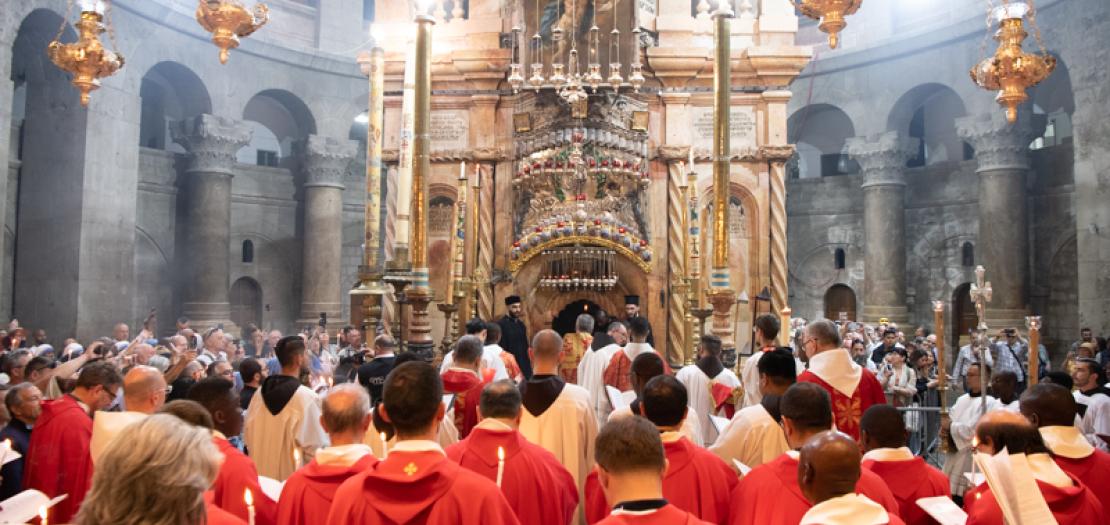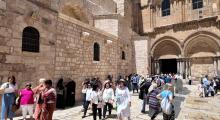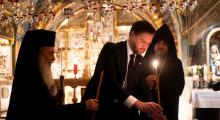Issued by the Catholic Center for Studies and Media - Jordan. Editor-in-chief Fr. Rif'at Bader - موقع أبونا abouna.org

This year again, on May 6-7, 2023, the celebrations for the feast-day of the Finding of the Cross of Christ took place in the Basilica of the Holy Sepulcher. The heart of the solemnity is the chapel of St Helena, in the ancient stone quarry on the lower level of the Basilica, where the inventio (“finding”) of the Holy Cross by the mother of the Emperor Constantine in 326, is remembered.
Jerusalem is the only place in the world where this feast-day is still celebrated, as Pope John XXIII eliminated it from the Roman calendar in 1960, in favor of the Feast of the Exaltation of the Cross on 14th September. The date chosen for the commemoration is 7th May because it was mentioned by St Cyril of Jerusalem, who told of a huge luminous cross that appeared in the sky, above Mount Golgotha, extending as far as the Mount of Olives.
The solemnity, in several liturgical parts, started in the afternoon of 6th May with the solemn entrance of the Custos of the Holy Land, Fr. Francesco Patton into the Basilica, where he was welcomed by the President of the Holy Sepulcher, Fr. Stéphane Milovitch. During the subsequent procession, which is held daily in the Basilica, the community of friars and faithful dwelled for a long time in St Helena’s Chapel: here, in front of the relic of the Holy Cross, the Father Custos, wearing red and gold vestments, presided the First Vespers.
In the same grotto, this was followed by the night office of the Vigil, in the course of which the passage taken from the History of the Church by St. Rufinus was read: it relates how St Helena was able to distinguish the cross of Jesus from the three crosses found, through a woman, who was severely ill, then recovered when she touched the “true” Cross.
On the morning of 7th May, the Father Custos presided at the Solemn Mass, which was attended by many faithful, religious and pilgrims. Lastly, at the end of the celebration, the relic of the Holy Cross was taken in procession as far as the Rotunda of the Anastasis, where the Empty Tomb was circled three times: rose petals and incense preceded the passage of the precious relic, which was then displayed for veneration by the faithful in the Chapel of the Apparition.
According to St Rufinus, St Helena was able to identify Golgotha due to the presence of a statue of Venus, placed there in the attempt to discourage worship by the first Christians and to lose the memory of the exact place of the events of the Lord’s Easter. “Hiding the cross in the lowest point of the quarry took place in the times of the Emperor Hadrian, by covering the Calvary and the Sepulcher under pagan temples,” Fr. Francesco Patton, Custos of the Holy Land, underlined in his homily. “Divine providence however, decided otherwise: the attempt to eliminate the memory of the Cross, Calvary and the Sepulcher corresponds to their finding and the transformation of this place into the heart of Christianity, in the place which emanates hope and gives meaning to the lives of each one of us and to the history of humanity.”
“This teaches us that when Christians seem to be suffering times of persecution and ordeal, they must not be discouraged, because they are entering the mystery of Easter together with Jesus: they are in the lobby of the Resurrection,” Fr. Patton continued. Today we are celebrating the finding of the true cross and once again we are invited to raise our eyes towards Jesus Christ on the cross. This is the only effective antidote against the bites of the many snakes that poison contemporary culture and that come from an insufficient ability to trust in God and His word. We need to be healed from the bites of enmity and hatred, which at personal level produce incomprehension and violence and at the collective level fuel wars and abuses of all kinds.”







